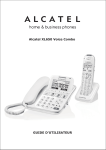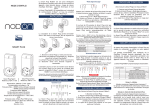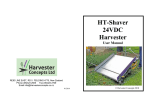Download USER GUIDE OCTAN REMOTE
Transcript
USER GUIDE The NodOn® Octan remote can be added and operated in any Z-Wave® network with other Z-Wave® certified devices from other manufacturers and/or other applications. All non-battery operated nodes within the network will act as repeaters regardless of vendor to increase reliability of the network. It has 2 distinctive working modes: be performed. The LED will display the battery level according to below table: LED state Green Orange Red Battery level Under 50% Between 50 and 20% Below 20% 1. «STANDALONE» MODE The Octan remote can control Z-Wave® compatible devices directly, such as the NodOn® Smart Plug or a light dimmer, whoever is the manufacturer. Note: No home automation gateway is involved and necessary in this mode. 2. «GATEWAY» MODE The Octan remote is in “Gateway” Mode as soon as it is added in a Z-Wave® network managed by a home automation gateway. The remote control becomes then the gateway’s assistant, capable to launch up to 16 different scenes through it (SCENE Profile) or directly associated to your Z-Wave® compatible devices (MONO or DUO Profile). FACTORY RESET A factory reset will completely delete the memory of the remote control and restore all the parameters to default value. A simultaneous long press (1sec) on O and M will perform this factory reset. The LED will blink red and green to validate the reset WALL SUPPORT A magnetic wall support is included with your Octan Remote. This support can be screwed (screws not included) or fixed by adhesive bonding (included). Careful : In “Standalone” Mode, make sure to remove all the devices added or associated in the remote control’s network before performing a factory reset. The remote control embeds a small magnet, allowing fixing it on its wall support or on any metallic surface (fridge door, heater, etc.). OCTAN REMOTE USAGE BATTERY REPLACEMENT The Octan remote operates using a CR2032 coin cell battery (included). To replace the battery, slide slowly the battery cover, located on the backside of the remote. OCTAN Remote with wall support Reference: CRC-3-1-0x Power supply: CR2032 battery Radio frequency: 868MHz Range up to 80 meters outdoor Range up to 40 meters indoor Operational temperature: -10°C / 50°C IP20 Radio protocol: Z-Wave Plus® (500 series) Dimensions: 80 mm (L) x 80 mm (l) x 17.5 mm (h) Weight: 68 g (with wall plate) Warranty: 2 years Before the first use, take care of removing the battery protector, after opening the battery cover. Careful : In order to save as much as possible the battery life time, avoid too long learning process, and place the remote control as close as possible to the device you want to associate. OCTAN REMOTE INTERFACE The remote control has 4 buttons and one LED located at the center of the product. Button 1 Button 2 Button 3 Button 4 BATTERY LEVEL In order to know the battery level, a simultaneous short press on I and P must In “Gateway” Mode, use the factory reset procedure only when the Primary Controller (i.e. the gateway) is missing or defective. Reset the remote control does not mean that it has been removed from the Primary Controller memory. Remove the remote controller (through the Primary Controller) before performing a factory reset. « STANDALONE » MODE By default, the Octan remote is in “Standalone” Mode. It means it can control ® compatible Z-Wave devices without involving the gateway. The Octan remote acts as the Primary Controller of the network. While the remote control is in “Standalone” Mode, you can: •Control one or several devices (up to 8) with only 1 button: MONO Profile. •Control one or several devices (up to 8) with 2 buttons: DUO Profile. Careful : You must not unplug a Z-Wave® device definitely without removing it from the remote control’s Z-Wave® network first (See the “Exclusion” part below). This can have a serious impact on the battery lifetime. ASSOCIATION Careful: Before associating a not recently bought device, please perform an ”EXCLUSION” first. Please refer to the “Exclusion” section below. Association is performed in 3 steps: 1 Push 3 times (quickly) on the I button to activate the “Association” Mode. The LED glows in blue 2 Choose which button will control your device, within 10 seconds. • A short press on one of the buttons of the remote control (I, O, P or M) will activate the MONO Profile. The pressed button will then control your device. • A long press on the I button will activate the DUO Profile, combined with the O button. The I (ON) and O (OFF) buttons will then control your device. • A long press on the P button will activate the DUO profile, combined with the M button. The P (ON) and M (OFF) buttons will then control your device. The LED blinks in blue to confirm your choice 3 Place the device you want to associate in “Learning” Mode, within 10 seconds. To do so, please refer to your device’s user guide. The LED of the remote control blinks green to confirm the association process Careful : In case of a too long association process or others problems during the process, the LED will blink red (Timeout). Please restart the procedure. Once the association is validated, your remote control is able to control your device. Different actions are possible. MONO PROFILE This profile allows controlling your associated device(s) using just a single button of the Octan remote. A short press on I, O, P or M (depending on your choice during association process) will activate (ON) your associated device(s), a second short press will deactivate (OFF) your associated device(s). If your device has dimming features (light dimmer, roller shutter, etc.): • A long press on the I, O, P or M (depending on your choice during association process) will dim up your associated device (light, roller shutter, etc.) until you release the button. • A second long press on the same button will dim down your associated device (light, roller shutter, etc.) until you release the button. ON & OFF Up & Down ON & OFF Up & Down Up & Down ON & OFF Up & Down ON & OFF DUO PROFILE This profile allows controlling your associated device(s) with two mutual buttons. • A short press on I (or P depending on your combination choice during association process) will activate (ON) your associated device(s). • A short press on O (or M depending on your combination choice during association process) will deactivate (OFF) your associated device(s). If your associated device(s) has dimming features (light dimmer, roller shutter, etc.): • A long press on I (or P depending on your combination choice during association process) will dim up your associated device (light, roller shutter, etc.) until you release the button. • A long press on O (or M depending on your combination choice during association process) will dim down your associated device (light, roller shutter, etc.) until you release the button. ON Up Down OFF ON Up Down OFF Carful : It’s not possible to cumulate a MONO and DUO profile on the same button. Repeat the association process as many times as you want to associate a new device. DESASSOCIATION The disassociation deletes any association relationship between the device and the remote control’s buttons linked to it. However, your device will remain in your remote control’s Z-Wave® network. 1 Push 3 times (quickly) on the P button. The LED blinks in blue 2 Place the device you want to disassociate in “Learning” Mode, within 10 seconds. To do so, please refer to your device’s user guide. The LED blinks in green to confirm the disassociation INCLUSION Inclusion allows adding a device into the remote control’s Z-Wave® network, without associating it with any buttons of the remote control. The remote control will then not be able to control your added device. 1 Push 3 times (quickly) on the O button. The LED blinks in blue 2 Place the device you want to add in “Learning” Mode, within 10 seconds. To do so, please refer to your device’s user guide. The LED blinks in green to confirm the inclusion EXCLUSION Exclusion allows removing your device from the remote control’s Z-Wave® network. 1 Push 3 times (quickly) on the M button. The LED blinks in blue 2 Place the device you want to remove in “Learning” Mode, within 10 seconds. To do so, please refer to your device’s user guide. The LED blinks in green to confirm the exclusion « GATEWAY» MODE When the Octan remote is in “Gateway” Mode, it only communicates with the home automation gateway, in order to launch scenes when the buttons are pressed. However, if your home automation gateway does not support scenes features, it is still possible to create direct association between the remote control and the compatible devices you want to control, through configuration parameters and association groups. Nonetheless, if supported, it is strongly advised to use scenes, in order to enjoy the best experience and increase the battery lifetime. In order to put your remote control into “Gateway” Mode, you just have to add the remote control into the gateway’s Z-Wave® network. Procedure as following: 1 Place your home automation gateway into “Inclusion” Mode. To do so, please refer to your gateway’s user guide. 2 Simultaneously push on I and P, during 1sec. The LED glows in pink to confirm the selection 3 Push on I, within 10 seconds. The LED blinks in pink to confirm your choice The LED blinks in green to confirm the procedure Warning : If your remote control controlled before some devices in “Standalone” Mode, these devices will remain orphans. Make sure you remove (or reset) all devices previously added or associated into the remote control’s network, before placing the remote control in “Gateway” Mode. If your home automation gateway supports the “Controller shift” feature, you can recover the existing remote control’s network (while it is in “Standalone” Mode) when you pass into “Gateway” Mode. Your home automation gateway will be added into the remote controller’s network, and set as the main controller. All the information related to the added devices will be automatically copied to the home automation gateway during this process. However, all existing association between the remote control and devices will be lost, and would need to be set-up again, using your home automation gateway interface. The existing network of the gateway will be lost as well The procedure is as following: 1 Place your home automation gateway into “Learning” Mode. To do so, please refer to your gateway’s user guide. 2 Simultaneously push on I and P, during 1sec. The LED glows in pink to confirm the selection 3 Push on P, within 10 seconds. The LED blinks in pink to confirm your choice The LED blinks in green to confirm the procedure REMOVE THE REMOTE CONTROL FROM THE NETWORK In order to remove the remote control from the gateway’s Z-Wave® network: 1 Place your gateway into “Exclusion” Mode. To do so, please refer to your gateway’s user guide. 2 Simultaneously push on I and P, during 1sec. The LED glows in pink to confirm the selection 3 Push on I, within 10 seconds. The LED blinks in pink to confirm your choice The LED blinks in green to confirm the procedure Expert Note: It’s possible to send just a single NIF by following this procedure: 1 Simultaneously push on I and P, during 1sec The LED glows in pink to confirm the selection 2 Push on O, within 10 seconds The LED blinks in pink to confirm your choice “GATEWAY MODE” FEATURES Warning : Make sure your gateway supports all the features of the Octan remote (compatible gateway are listed on www.nodon.fr/en ). INCLUSION ON BEHALF OF THE GATEWAY 1 Push 3 times (quickly) on the I button. The LED blinks in blue 2 Place the device you want to add in “Learning” Mode, within 10 seconds. To do so, please refer to your device’s user guide. The LED blinks in green to confirm the inclusion EXCLUSION ON BEHALF OF THE GATEWAY 1 Push 3 times (quickly) on the M button. The LED blinks in blue 2 Place the device you want to remove in “Learning” Mode, within 10 seconds. To do so, please refer to your device’s user guide. The LED blinks in green to confirm the exclusion ASSOCIATION GROUPS Once set-up through the gateway, association groups allow direct communication between the remote control and the Z-Wave® devices you want to control, without involving the gateway in the communication. The Octan Remote has 7 associations groups: Group 1 2 3 4 5 6 7 Groupe Name Lifeline Button 1 - Mono - Controlled nodes Button 2 - Mono - Controlled nodes Button 3 - Mono - Controlled nodes Button 4 - Mono - Controlled nodes Button 1&3 - Duo - Controlled nodes Button 2&4 - Duo - Controlled nodes Group 1 – Lifeline Maximum number of devices in the group: 1 This group is dedicated for the home automation gateway Group 2/3/4/5 Maximum number of devices in the group: 8 Devices associated in these groups are controlled by the corresponding button, according to MONO Profile (in the exact same way as « Standalone » Mode). Group 6/7 Maximum number of devices in the group: 8 Devices associated in these groups are controlled by the corresponding buttons, according to DUO Profile (in the exact same way as « Standalone » Mode). CONFIGURATION PARAMETERS Buttons’ profile (MONO/DUO/SCENE), in « Gateway » Mode, are set-up through several configuration parameters. BUTTONS 1&3 PROFILE Parameter Number Default Value 1 0 To set-up the profile of buttons 1 & 3 Value Description 0 SCENE 1 MONO 2 DUO Size 1 [byte] BUTTONS 2&4 PROFILE Parameter Number Default Value 2 0 To set-up the profile of buttons 2 & 4 Value Description 0 SCENE 1 MONO 2 DUO Size 1 [byte] SCENE TYPE Parameter Number Default Value Size 3 0 1 [byte] To choose the way of sending Scene to the gateway Value 0 1 Description CENTRAL SCENE SCENE ACTIVATION We strongly advise you to use « CENTRAL SCENE », which is more user friendly. However, some home automation gateways don’t support « CENTRAL SCENE » yet, then you can still use the previous standard « SCENE ACTIVATION ». The user interface of your gateway will then allow you to set-up scenes BUTTON 1 CONFIGURATION Parameter Number Default Value Size 4 0 1 [byte] To set-up the how button 1 behaves, when set in MONO Profile Value Description 0 Control Group 2 1 All Switch ON 2 All Switch OFF BUTTON 2 CONFIGURATION Parameter Number Default Value Size 5 0 1 [byte] To set-up the how button 2 behaves, when set in MONO Profile Value Description 0 Control Group 3 1 All Switch ON 2 All Switch OFF BUTTON 3 CONFIGURATION Parameter Number Default Value Size 6 0 1 [byte] To set-up the how button 3 behaves, when set in MONO Profile Value Description 0 Contrôle Groupe 4 1 All Switch ON 2 All Switch OFF BUTTON 4 CONFIGURATION Parameter Number Default Value Size 7 0 1 [byte] To set-up the how button 4 behaves, when set in MONO Profile Value Description 0 Control Group 5 1 All Switch ON 2 All Switch OFF When the selected profile is « SCENE » (default value), the remote control communicates only with the home automation gateway. The user interface of your gateway will then allow you to set-up scenes based on which (and which way) you press the different buttons. To do so, please refer to your gateway’s user guide. The different actions that can be handled by the remote control are: • Simple press (on I, O, P or M) • Double press (on I, O, P or M) • Long press (on I, O, P or M) • Button released (on I, O, P or M) Which makes a total of 16 different actions. It is strongly advised to use this profile if supported by your gateway. However, if your home automation gateway does not support these features, you can still use association groups and set-up your buttons as • MONO Profile, to control the corresponding group or activate the Z-Wave® « All Switch ON » or « All Switch OFF » features. • DUO Profile, to control the corresponding groups. LED MANAGEMENT Parameter Number 8 Value 0 1 2 3 Default Value Size 0 1 [byte] How to set up LED behaviour Description No LED Flash Blue after button press Blinking to confirm command Both options above (1&2) COMMAND CLASS The Octan remote supports the following Command Class: COMMAND CLASS VERSION All switch* V1 Application status* V1 Association V2 Association Group Information V1 Basic* V1 Battery V1 Central Scene** V2 Configuration V1 Device Reset Locally V1 Manufacturer Specific V2 Multilevel Switch* V3 Power Level V1 Scene Activation* V1 Version V2 Wake-Up** V2 V2 Z-Wave® Plus info** * Controlled only (not supported) ** Controlled AND supported DECLARATION OF CONFORMITY EN 301489-1 V1.9.2 & EN301489-3: V1.4.1 EN 62479: 2011-9 EN 60950-1:2006+A11:2009+A1:2010 EN 300220-1: V2.4.1 & EN 300220-2: V2.4.1 LOGOTYPE This product is compliant with all relevant European standards. When sorting your waste, please observe the disposal regulations in force. Please place your waste in the facilities provided for that purpose and with all due respect for the environment. This product must be used indoor only. This product is compatible with Z-Wave® and Z-Wave Plus® protocol. CONTACT NodOn® by ID-RF: ID-RF SAS 121 rue des Hêtres 45590 St CYR EN VAL (FRANCE) AFTER SALES www.nodon.fr section “support” contact@nodon.fr For user guides in other languages, please visit www.nodon.fr/notices











